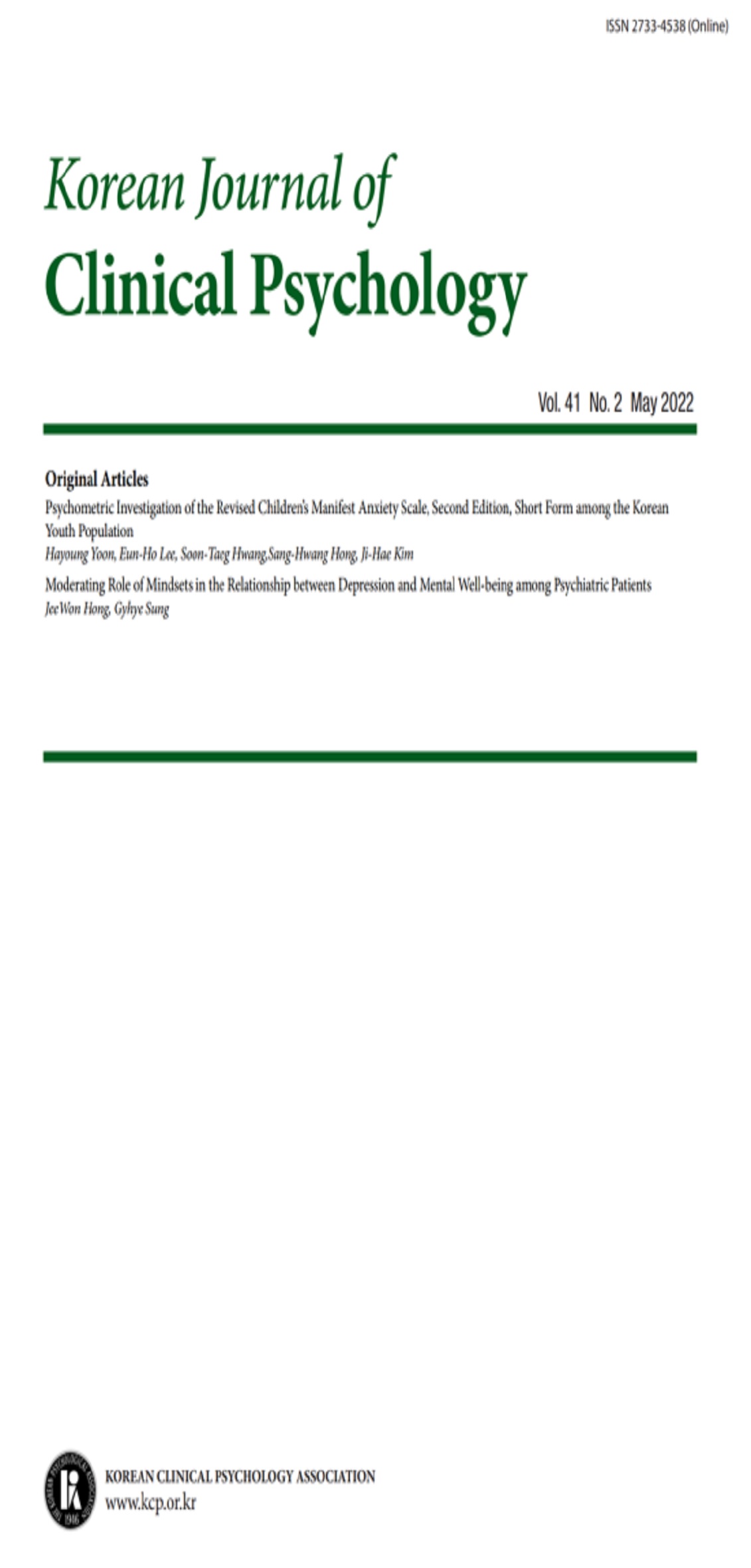open access
메뉴
open access
메뉴 E-ISSN : 2733-4538
E-ISSN : 2733-4538
본 연구는 주요우울증 환자집단(우울집단)과 정상집단간의 대뇌 활동을 뇌전위분석(electroencephalogram: EEG)을 통해 비교하였고 임상적 진단도구로서 EEG의 활용성을 평가하였다. 이를 위하여 세타, 알파, 베타의 주파수영역 대에서 절대파워, 상대파워를 산출하였으며 우울증에서 나타나는 좌, 우뇌 반구 간 비대칭적인 활동성을 정량화하기 위해 PCT지표와 A지표를 구하여 활동 패턴의 차이를 확인하였다. 그 결과, 우울집단의 상대델타파워는 후두엽을 제외한 모든 영역에서 정상집단보다 높았으며 상대알파파워는 전두엽에서 유의미하게 적었다. 델타주파수는 우울집단이 정상집단에 비해 유의미하게 느렸으며 알파주파수는 전두엽에서 우울집단이 빠른 패턴을 보였다. 한편 우울집단은 우울증에서 특징적인 알파파워 반구 간 비대칭성과 베타파의 반구 간 비대칭성을 나타냈다. 이를 PCT 지표로 산출하였을 때, 알파, 베타 비대칭성 이외에 세타 비대칭성 까지 관찰할 수 있었다. 위와 같은 지표들을 포함한 판별분석 결과 A지표가 포함되었을 때 82.6%, PCT 지표가 포함되었을 때 87%의 비교적 높은 판별율로 각 집단을 구분할 수 있었다. 이런 결과는 EEG 분석이 주요우울증 환자들의 대뇌활동 특징을 확인하고 임상적 진단을 내릴 때 유용한 도구가 될 수 있다는 것을 보여준다.
In an attempt to compare the brain activity between patients with major depressive disorder (MDD) and a normal control group, we analyzed the Quantitive Electroencephalography (QEEG) and we evaluated the possibility of QEEG as a useful clinical tool. The taditional measures of absolute and relative power and frequency, and the asymmetry measures were derived from the ranges of the delta, theta, alpha and beta frequencies. The asymmetry indexes were computed using two different formulas: the PCT index and the A index. The results showed the following. (1) The delta relative to power was increased and the alpha relative to power was decreased in the depressed patients, as compared to the controls. (2) The delta frequency was slower and the alpha frequency was faster in the depressed patients, as compared to the controls. (3) With the A index, the alpha and beta asymmetries were indicative of the left frontal and central hypoactivity, respectively, as was previously reported for MDD patients. However, theta asymmetry was also found in the PCT index, in addition to the alpha and beta asymmetries. Discriminant analysis correctly classified 82.6% and 87% of the patients (Ed note: check this.) when the A index and the PCT index were included, respectively. It was found that spectrally analyzed EEG could become a useful tool when diagnosing major depression and also for examining the basis of the symptoms.
강연욱 ; 이병철 ; 오은아 ; 김진혁 ; 유경호, (2006) 혈관성 치매 집단에서의 우울증과 인지기능 및 병소의 관계, 한국심리학회지 임상
이준석 ; 양병환 ; 오동열 ; 김기성, (2007) 주요우울증에서 우울과 불안 증상의 심각도에 따른 뇌파 A1, A2, Percent 비대칭 지표들의 특성 연구, 신경정신의학
Adler, G., (1999) Mild cognitive impairment in old-age depression is associated with increased EEG slow-wave power, Neuropsychobiology
Alper, K., (1995) Quantitative EEG and evoked potentials in adult psychiatry, Advances in Biological Psychiatry
Austin, M.P., (1992) Cognitive function in major. depression, Journal of Affective Disorders
Baehr, E., (1998) Comparison of two EEG asymmetry indices in depressed patients vs. normal controls, International Journal of Psychophysiology
Coan, J. A., (2004) Frontal EEG asymmetry as a moderator and mediator of emotion, Biological Psychology
Davidson, R. J. , (1992) Anterior cerebral asymmetry and thenature of emotion, Brain and Cognition
Davidson, R. J., (2000) Regional brain function in sadness and depression in The Neuropsychology of Emotion, Oxford University Press
Davidson, R. J., (2002) Depression: Perspectives from affective neuroscience, Annual Review of Psychology
deBeus, R., (1999) QEEG Relationships With the MMPI-2 Depression Scale and Subscales, Paper presented at the advanced qEEG workshop of the Society for Neuronal Regulation
Field, T., (1995) Relative right frontal EEG activation in 3-to 6-month old infants of depressed mothers, Developmental Psychology
Gotlib, I. H., (1998) Frontal EEG alpha asymmetry, depression, and cognitive functioning, Cognitive and Emotion
Henriques, J. B., (1990) Regional brain electrical asymmetries discriminate between previously depressed and healthy control subjects, Journal of Abnormal Psychology
Knott, V. J., (1987) Computerized EEG correlates of depression and antidepressant treatment, Progress in Neuropsychopharmacology and Biological Psychiatry
Knott, V., (2001) EEG power, frequency, asymmetry and coherence in male depression, Psychiatry Research Neuroimaging
Kuskowski, M. A., (1993) Rate of cognitive decline in Alzheimer’s disease is associated with EEG alpha power, Biological Psychiatry
Kwon, J. S., (1996) Right hemisphere abnormalities in major depression: Quantitativeelectroencephalographic findings before and after treatment, Journal of Affective Disorders
Lieber, A., (1988) Diagnosis and subtyping of depressive disorders by quantitative electroencephalography: I. Discriminant analysis of selected variables in untreated depressives, Hillside Journal of Clinical Psychiatry
Matousek, M., (1991) EEG patterns in various subgroups of endogenous depression, International Journal of Psychophysiology
Monakhov, K., (1980) Neurophysiological correlates of depressive symptomatology, Neuropsychobiology
Pizzagalli, D. A., (2002) Brain electrical tomography in depression: t,
Pollock, V. E., (1990) Quantitative, waking EEG research on depression, Biological Psychiatry
Pollock, V. E., (1990) Topographic quantitative EEG in elderly subjects with major depression, Psychophysiology
Prichep, L., (1986) Quantitative EEG in depressive disorders, Brain Electric Potentials and Psychopathology
Roemer, R. A., (1992) Quantitative EEG in elderly depressives, Brain Topography
Smit, D. J. A., (2007) The relation between frontal EEG asymmetry and the risk for anxiety and depression, Biological Psychology
Volf, N. V., (2002) EEG mapping in seasonal affective disorder, Journal of Affective Disorder
